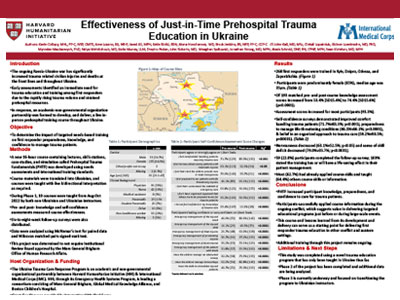ABSTRACTS
Effectiveness of Just-in-Time Prehospital Trauma Education in UkraineAuthor: Kevin Collopy, MHL, FP-C, NRP, CMTE | | Associate Authors: Amelia Lozano, BS, NRP, Honcharova Goncharova, MD, Brock Jenkins, BS, NRP, FP-C, Jill John-Kall, MD, Myroslav Mardarevych, PhD, Katie Murray, LLM, John Roberts, MD, Alexis Schmid, DNP, RN, CPNP, Katie Biniki, RN, BSN, CEN, TCRN, Sean M. Kivlehan, MD, MPH
Introduction The ongoing Russia–Ukraine war has significantly increased trauma-related civilian injuries and deaths at the front lines and throughout Ukraine. Early assessments identified an immediate need for trauma education and training among first responders due to the rapidly rising trauma volume and strained prehospital resources. In response, an academic nongovernmental organization was formed to develop and deliver a live in-person prehospital training course throughout Ukraine. Objective To evaluate the value of a live, in-person education and training course in preparing first responders to care for trauma patients. Methods A new 16-hour course containing lectures, skills stations, case studies, and simulation called Prehospital Trauma Fundamentals (PHTF) was developed using needs assessments and international training standards. Course materials were translated into Ukrainian, and courses were taught with live bidirectional interpretation as required. Ten courses were taught from August–November 2022 by both non-Ukrainian and Ukrainian instructors. Pre- and post-knowledge and self-confidence assessments measured course effectiveness. Six- to 8-week follow-up surveys were also distributed. Data were analyzed using McNemar’s test for paired data and Wilcoxon matched-pairs signed-rank test. This project was determined to not require Institutional Review Board approval by the Mass General Brigham Office of Human Research Affairs. Results A total of 268 first responders were trained in Kyiv, Dnipro, Odessa, and Zaporizhzhia. Participants were predominantly female (65%); median age was 35 years. Pre- to post-course knowledge assessment scores increased from 53.4% (SD 15.4%) to 74.4% (SD15.6%; p < 0.001). Assessment scores increased for most participants (93.3%). Self-confidence surveys demonstrated improved comfort handling trauma patients (71.7% vs. 83.3%; p < 0.001), preparedness to manage life-threatening conditions (46.1% vs. 66.1%; p < 0.0001), and belief in an organized approach to trauma care (59.2% vs. 90.5%; p < 00001). Nervousness decreased (63.1% vs. 52.5%; p < 0.05) and sense of skill deficit decreased (79.0% vs. 33.7%; p < 0.0001). Fifty-nine (22.0%) participants completed the follow-up survey; 100% stated the training has or will have a life-saving effect in their patient management. Most (62.7%) had already applied course skills and taught (64.4%) others course skills or information. Conclusion PHTF increased participant knowledge, preparedness, and confidence to care for trauma patients. Participants successfully applied information taught during the ongoing conflict, which suggests value in delivering targeted educational programs just before or during large-scale events. This course and lessons learned from its development and delivery can serve as a starting point for delivering first responder trauma education in other conflict and austere settings. Additional training through this project remains ongoing.
|

